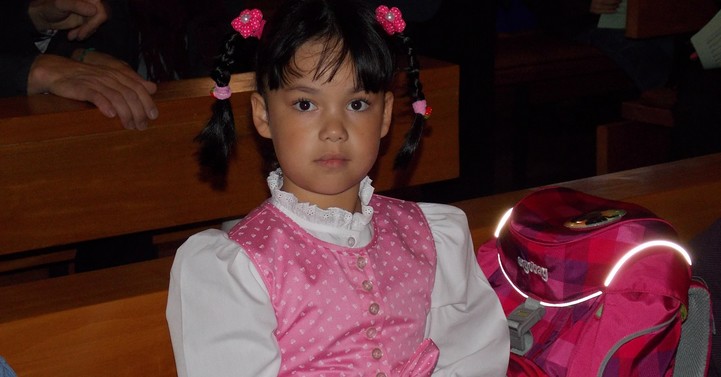
Being “the new kid on the block” is a feeling many of us can relate to. Being in a new environment can be emotionally challenging. Leaving home, friends, and all that’s familiar to relocate to a completely new community is especially hard, even for the most adaptable children. If you work with military families, you know that relocation, or PCS (Permanent Change of Station), can be a very common experience. With each move, parents and children experience the discomfort of being surrounded by the unfamiliar.
Child care providers are in a unique position to help children adapt to their new child care environment and to help the whole family get connected and comfortable in their new community. Recalling your own discomfort, loneliness, and confusion of being in an entirely new place can help you empathize with and support young children from military families who have relocated. With the help of caring, wise adults, young children can practice the coping skills that will enable them to adapt well to big changes in their future.
Before the First Day
Fear is a very common human response when we are facing the unknown, and information is often the best remedy. Here are a couple of ways you can help a new child start to build a mental picture of the new place he’ll soon be a part of by giving him information about his new child care program before that first day.
-
Put together a “Welcome Book” photo album that you can send home with each new family as soon as they are enrolled. (This could also be an online photo album or “virtual tour” of the child care program.) Some suggestions of photos to include:
-
Main areas of the classroom (include “routine” spaces, such as the bathroom and the child’s cubby as well as play spaces).
-
Toys and activities that are big draws for most kids.
-
The classroom during important times of the day (such as lunch and outdoor play).
-
The teachers (don’t forget to print their names!).
-
Include some text that explains something about each shot. Remember, the intent is to reduce the child’s “first day jitters” by making the child care environment more familiar and inviting.
- Invite the family to visit the program together before their actual start date and to stay for at least an hour. If possible, that visit should include some free-play time, a snack or meal, and a group activity of some kind. This is a great way for child and parents to get to know what a typical day looks like and to begin feeling comfortable in the new child care environment. Be sure to let the parent(s) know that you have no expectations that their child participate. Some children will jump right in to the flow of activity; others may prefer to watch from the safe distance of their parent’s lap. Both “views” of the new environment, and variations in between, are valuable for giving a child information about the people, things, and events in this strange new place. Pushing a child to participate may have the exact opposite effect that the visit was intended to create!
- Encourage the family to have the child attend for half days for the first week or to plan on some other partial schedule initially if at all possible. Navigating a new environment that’s as action-packed as child care is exhausting for most children – physically, emotionally, and mentally – even for a child who is enjoying the experience. Easing into the full-time schedule gradually is a supportive way to acknowledge and accommodate the energy required for all that hard work.
Helping a Child Navigate the First Days
Here are a few simple ways you can help a new child navigate the first day or two at child care with as few upsets as possible.
- If you are the child’s primary caregiver or teacher, the most important message that you need to convey is that she can trust you to be a friendly face in this strange new place – someone who will watch out for her, introduce her to new people and things, answer any question, and be a secure base that she can return to after every foray into the action. Be sensitive to the child’s comfort level with physical touch (holding her hand, holding her on your lap, hugs, etc.). Although you mean it as comfort and affection, different children will experience physical touch from an unfamiliar adult differently. Respect each child’s temperament and personal style when finding ways to support and encourage her.
- Make sure she knows the most vital information: where the bathroom is, what your name is, the most important safety rules, and that her parent will be coming back soon. If you need to leave the room, tell her where you’re going and who she can ask for help while you’re gone.
- Introduce the child during group time, but be sensitive to how much attention you focus on her – not all children like being in the spotlight. Throughout the day, be intentional about bringing her into conversations. Mention things about her or her family so that the other children get to know her better. Offer her opportunities to participate and help throughout the day (e.g., “Would you like to help Charlie set the table?” or “There’s one more spot on the tire swing. Would you like to join Tasha and John?”), but respect her right to decline the invitation.
- Post a picture schedule of each part of the day. Shortly after the child arrives (and while the parent is still there, if possible), take a look at each picture and talk about what it means. Throughout the day, bring the child back to the schedule as each transition approaches. Take a minute or two to help her make connections between each scheduled activity and similar experiences she has had at home or in a previous child care setting (e.g., “Do you have lunch at your house? What’s your favorite food to have at lunch time?”). Use the picture schedule as a reference for letting her know when her parent will be coming to take her home.
- Do you have a child in your program who has a high degree of “social intelligence” – especially sensitive to other people’s emotions, communicates well with other children, and is well-liked by others? Ask him or her to be the new child’s “buddy” for the first few days. The buddy role will depend on the needs and personality of the new child, but it might be as simple as sitting next to her at lunch and snack, inviting her to play, and helping her find her way to the bathroom or the playground. Keep an eye on the interactions between buddy and new child; some children can become overzealous about their helping role. Offer feedback to the buddy about boundaries as needed (e.g., “I think she can put her own coat on, Kara, but thank you for wanting to be helpful. Next time you want to help, ask her first.”).
- Take photos throughout the day of positive moments. Include those that the child actively participated in and others that she just observed but will remember. Print the photos and share them with the parents at the end of the day, or send them to parents via email. These pictures can remind the child of what she did during the day and are a great way for parents and child to talk about her first day’s experiences and look forward to the next day in very specific ways. The photos can also be a catalyst for parents to ask their child how she’s dealing emotionally with the transition and to provide the support and encouragement she needs.
Making Connections to Home
Even when a child is quickly adapting to and enjoying his new child care environment, he still needs to feel a strong connection to home and family – the core of his sense of security. Happily, there are many simple yet meaningful things you can do that will enable him to reconnect whenever he’s feeling a little lonely or insecure.
- Encourage the parents to send a small photo album of family, pets, and the child doing some of his favorite things. These will not only bring him comfort but will also give him something to talk about with others.
- Allow the child to bring a special item from home, such as a stuffed animal or favorite toy. If you have a general rule about not bringing toys from home, you may need to set some boundaries, such as “You’ll need to keep this in your cubby, but you can come to your cubby to hold it or play with it whenever you feel like it.” Even though you are making an exception to your rule for one child, other children tend to be surprisingly accepting of “bending the rules” when the teacher takes time to explain in simple terms. You might say, “This is David’s first day and he’s feeling a little sad and afraid. Holding his toy for a little while makes him feel better. It’s not your first day, so you didn’t need to bring a toy from home to help you feel better.”
- Include a display of each child’s family pictures somewhere in the children’s environment, at their eye level, and make sure the new family is represented in the photos. The family picture provides comfort and connection to home for the new child and gives the child something in common with all the other children. Finding those similarities and connections to other children is the first step in developing a sense of belonging to the classroom community.
- Include toys and materials that reflect military life throughout the classroom: pieces of military clothing and military props in the dramatic play area, books and picture displays representing military families, military vehicles as props in the block area, etc. Having a military parent is an important part of a child’s identity. Including elements throughout the classroom that reflect their military parent provides a child with lots of opportunities for connecting home and school.
Adjusting Is a Process
These are just a few suggestions for helping a new military child feel more comfortable and at home in his new child care environment. Remember that feeling at home is a process – the accumulation of many small, positive experiences in getting to know a new place and new people, being welcomed and included, and finding favorite things in common.
Keep in mind that children can differ widely in how long that process takes and how much adult support they need along the way. Talking with parents early on about the child’s adjustment to previous experiences in new environments, and continuing the conversation as the child adjusts to this one, will help you be the sensitive, encouraging guide the child needs.
For More Information
To learn more about child care for children in military families, check out the following eXtension Alliance for Better Child Care articles:
- Coping with Change: Young Children in Military Families Find Comfort in the Familiar
- Coping with Change: Practical Ways that Child Care Providers Can Support Young Children from Military Families
- Ensuring that Children’s War Play Is Healthy, Safe, and Positive
- How Child Care Providers Can Help Deployed Parents and Their Children Stay Connected
- Reflections of Military Life in Children’s Pretend Play
- Strategies Child Care Providers Can Use to Help Young Children in Military Families Relieve Stress

